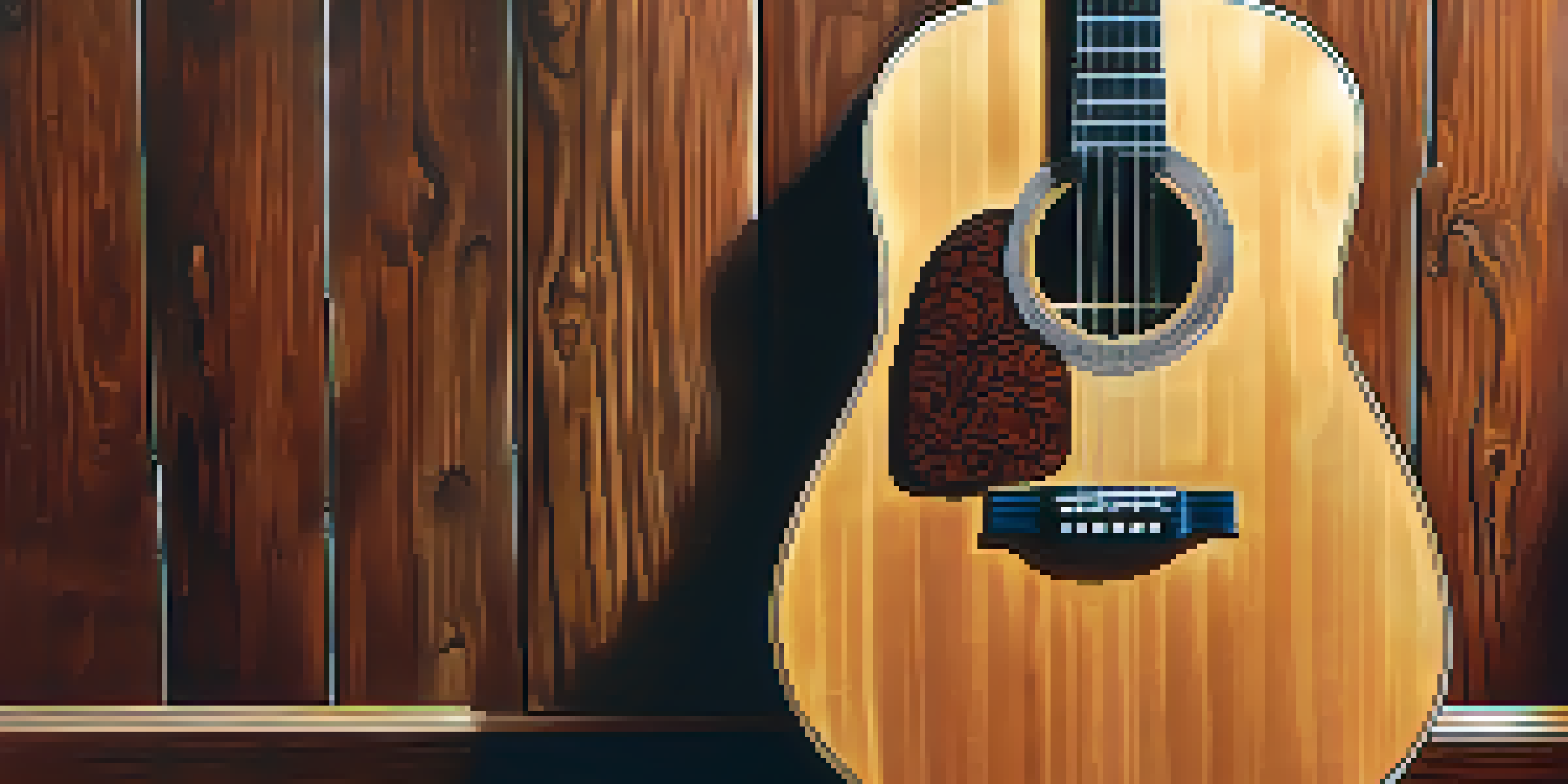Creating Unique Sounds with Alternate Tunings on Your Guitar

Understanding Alternate Tunings and Their Benefits
Alternate tunings are simply different ways to tune the strings of your guitar, deviating from the standard EADGBE tuning. This method can open up a treasure chest of new sounds and textures that you might not encounter with standard tuning. By experimenting with alternate tunings, you can find fresh inspiration for songs and riffs that feel unique and exciting.
Music can change the world because it can change people.
One of the biggest benefits of using alternate tunings is the ability to create new chord voicings. For example, tuning to open D (DADF#AD) allows you to play rich, resonant chords that are difficult to achieve in standard tuning. This can be especially beneficial for songwriters looking to differentiate their sound or for players seeking to explore new genres.
Additionally, alternate tunings can make certain fingerings easier, especially for slide guitar or fingerstyle playing. By repositioning the strings, you may find that your fingers can navigate the fretboard with more ease, allowing for greater creativity and expression in your playing.
Popular Alternate Tunings to Try
There are countless alternate tunings out there, but some have stood the test of time and become favorites among guitarists. For instance, the Drop D tuning (DADGBE) lowers the sixth string to D, making it easier to play power chords. This tuning is widely used in rock and metal genres, offering a heavier sound with minimal effort.

Another popular choice is the open G tuning (DGDGBD), favored by artists like Keith Richards and Robert Johnson. This tuning allows for easy slide playing and creates a rich, full sound that’s perfect for blues and folk music. The open strings resonate beautifully, providing a captivating backdrop for melodies.
Discover Fresh Sounds with Tuning
Experimenting with alternate tunings can unlock new sounds and inspire unique songwriting.
Lastly, consider exploring the C6 tuning (CACEGC), often used in Hawaiian and country music. This tuning gives a bright, shimmering quality to your chords and is fantastic for creating lush harmonic textures. Each of these tunings has its own unique character, waiting for you to discover.
How to Experiment with Alternate Tunings
When diving into alternate tunings, start by selecting one that intrigues you. It can be helpful to listen to songs that utilize that tuning so you can get a feel for its potential. For instance, if you’re trying open D, check out songs like 'Girl from North Country' by Bob Dylan to see how it’s used creatively.
The only truth is music.
Once you’ve chosen a tuning, take some time to familiarize yourself with the new chord shapes and scales. You might want to grab a chord chart or use an app to help visualize the new finger placements. Allow yourself the freedom to stray from traditional progressions; sometimes the best ideas come from happy accidents.
Don’t forget to record your jam sessions! Documenting your explorations can help you capture those spontaneous moments of creativity. You might stumble upon a riff or progression that you want to develop further, and having a recording will help you remember that magic.
Creating Unique Melodies with Alternate Tunings
One of the most exciting aspects of alternate tunings is the new melodies you can craft. The altered tension of the strings can inspire different melodic lines than what you might typically play. For example, in open tunings, certain intervals can sound richer and more resonant, encouraging you to explore new musical ideas.
Try playing scales in the new tuning to find unique note combinations. You'll often discover that the same scale shapes yield different sounds, which can lead to unexpected musical twists. This is where your creativity can flourish, as you adapt your playing style to the new sonic possibilities.
Enhance Creativity through Chords
Using alternate tunings allows for new chord voicings and easier fingerings, fostering greater musical expression.
Combining melodies with open strings can also create a lush soundscape. By letting open strings ring while you play fretted notes, you can achieve a beautiful harmonic layering effect that adds depth to your music. This technique is particularly effective in fingerstyle playing, where the interplay of notes can create a captivating listening experience.
Enhancing Your Songwriting with Alternate Tunings
If you find yourself stuck in a songwriting rut, trying alternate tunings may provide the spark you need. A fresh tuning can inspire new chord progressions and lyrical themes, breaking you out of repetitive habits. Sometimes, the mere act of re-tuning your guitar can shift your mindset and open the door to creativity.
Consider using a specific alternate tuning as the foundation for a song. For example, in open C tuning (CGCGCE), you might find that your songwriting takes on a different emotional quality, leading to different lyrical content. Each tuning has its own story to tell, and you can harness that to craft your music.
As you write in alternate tunings, experiment with how the structure of your songs changes. You may find that certain chord transitions feel more natural or that your verses and choruses evolve differently. This exploration can lead to a unique and personal sound that sets your music apart from others.
Using Alternate Tunings for Live Performances
When it comes to live performances, alternate tunings can add an exciting element that captivates your audience. The distinct sound of alternate tunings can enhance your setlist, making even familiar songs feel fresh and new. Imagine the surprise on your audience's faces when they hear a beloved tune performed in a completely different light!
However, switching tunings mid-performance can be challenging. It’s essential to practice transitioning smoothly between tunings in your setlist. You might choose to play a few songs in one tuning before switching to another, allowing your audience to fully appreciate the change in sound.
Engage Audiences with Unique Performances
Incorporating alternate tunings in live performances can surprise and captivate your audience.
Consider sharing your tuning choices with the audience. Explaining your creative process can foster a deeper connection with listeners, inviting them into your musical journey. This engagement not only enhances the performance experience but also builds a community around your music.
Conclusion: Embrace the Journey of Alternate Tunings
Exploring alternate tunings can be a rewarding experience that enriches your guitar playing. It encourages you to step outside of your comfort zone and discover new musical landscapes. Whether you're a seasoned player or just starting, there's always something new to learn from experimenting with your instrument.
As you venture into different tunings, remember that the goal is to have fun and express yourself. Allow the unique sounds to guide you, and don't be afraid to make mistakes along the way. Each misstep can lead to unexpected discoveries and personal growth as a musician.

Ultimately, the beauty of alternate tunings lies in their ability to inspire creativity and individuality. So grab your guitar, tune up, and let your imagination run wild—there's a world of unique sounds waiting for you!